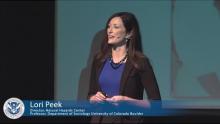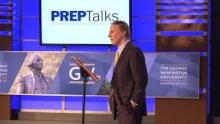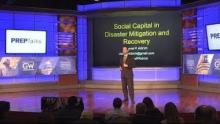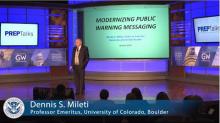
PrepTalks are given by subject-matter experts and thought leaders to spread new ideas, spark conversation and promote innovative leadership for the issues confronting emergency managers.
To assist emergency managers with implementing insights from the PrepTalks, each PrepTalk page includes the video, facilitator slides and a discussion guide to assist with whole community planning.
Featured PrepTalk
Search PrepTalks
PrepTalks are organized by the following categories:
- Threats, Hazards, Risks
- Communications & Situational Awareness
- Individuals & Civic Engagement
- Local Government & Community Partners
- Emergency Management Leadership
Search below for videos and discussion materials.
Kristina Anderson shares her experience during the Virginia Tech shooting in 2007 and translates her experience into priorities for schools to identify and mitigate potential threats.
Dr. Lori Peek examines the needs of children in disasters and explains ways to work with children before disasters strike.
Sarah Thompson demonstrates how children are the foundation for building a culture of preparedness and shares how to involve youth in disaster preparedness.
John Hope Bryant explains why emergency managers should include financial literacy as a priority and how disaster recovery dollars could improve the financial resilience for those in poverty.
Francis Ghesquiere presents a global perspective on the need to improve disaster resilience and highlights the scale of the challenge due to rapid urbanization in high-risk areas.
Dr. Robert Chen outlines the different ways data mapping can be used to help emergency managers identify those at risk before, during, and after a disaster.
John M. Barry showcases lessons learned from the 1918 and 2009 influenza pandemics and provides guidance on what emergency managers can do to work with public health and elected officials.
Dr. Daniel Aldrich highlights how different types of social capital (bonding, bridging, and linking) serve to increase community resilience.
Amanda Ripley combines the inspiring stories of disaster survivors with research into how the brain works when confronted with unusual events.
Dr. Dennis Mileti showcases the latest research on public alerts and warnings and provides practical guidance on how to write effective messages.
PrepTalks are a partnership of FEMA and National Emergency Management Agency (NEMA), National Homeland Security Consortium (NHSC), International Association of Emergency Managers (IAEM) and Naval Postgraduate School's Center for Homeland Defense and Security (NPS-CHDS).
Contact
Please send us an email with questions or comments on PrepTalks.











